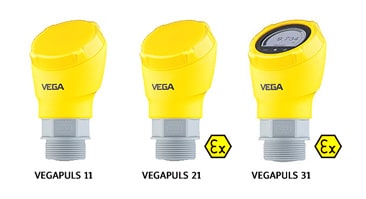
What Is The Difference Between Radar & Ultrasonic?

Thorne & Derrick work with VEGA, a world leader in process instrumentation sensors specialising in pressure measurement and level measurement (switching) technology suitable for many worldwide applications – including hazardous area industries requiring Zone 1 & Zone 2 ATEX & IECEx certified level and pressure sensors.
The technology that VEGA uses is constantly evolving to make sure it can meet the demands of the environments the sensors operate in.
All instruments will perform accurately and reliably for all media and process conditions. VEGA sensors use different measuring principles when measuring the level or point level of liquids, solids, powders and gases.
Today we are dealing with the age old question – What is the difference between Radar and Ultrasonic?
In order to answer this question, you have to understand how the two of these measuring principles work.
HOW DO RADAR AND ULTRASONIC WAVES WORK?
Both measuring principles omit signals, either sound waves or radar waves, which are reflected by the medium in the tank. The electronics then calculate the distance from the total time lapsed from omission to reception.
Just like a bat.
The sound waves are reflected by it’s prey and the bat picks up the echoes. The time difference allows the brain of the bat to sense the environment to determine how far away insects or obstacles are.
However, there are differences between radar and ultrasonic.
Radar signals travel much faster than Ultrasonic sound waves. The speed doesn’t really matter, but the electromagnetic waves omitted by the radar sensor have a number of advantages over ultrasonic sound waves.
Sound waves need air to travel through – this means that anything that travels through the air also affects the ultrasonic sound signal; for example, wind, temperature, vapours or gases. Radar is also much more reliable in the presence of build up.
When you take all aspects into consideration, radar is the more reliable and effective solution.
Non-contact level measurement with radar is characterised by a particularly high measurement accuracy. The measurement is affected neither by fluctuating product properties nor by changing process conditions such as temperature, pressure or intense dust generation. User-friendly adjustment without vessel filling and emptying saves time.
HOW A RADAR LEVEL SENSORS CONVERT A SIGNAL TO A MEASUREMENT
In radar level measurement, microwaves are transmitted by the antenna system of the radar sensor to the measured product, reflected by the product surface, and received back by the antenna system. The time from emission to reception of the signals is proportional to the level in the vessel.
The integrated electronics converts the measured value into an analogue or digital signal for transmission. This signal can be used for an external display or a process control system. Additional components for Ex separation, overvoltage protection or wireless communication enable a wide range of applications in all industrial sectors.
If you’re looking for a solution for a difficult application, Thorne & Derrick together with VEGA can help choose the right measurement technology.
➡ Watch the full video below
External URL: https://www.heatingandprocess.com/radar-vs-ultrasonic/
By Thorne & Derrick International
696 Views
Recent Posts
- Genesis Models ED1 & ED2: Case Study Model ED1 Installed on Desalter at Refinery
- Protective coatings offer a robust solution for safeguarding your assets.
- Introducing the Tab-Ex® 05: Future-Ready Mobility for Industry
- NEPIC spoke with px Group to discover more about the organisation supporting women in industry and apprenticeships on Teesside
- Enhancing caustic soda production with clamp-on ultrasonic flow measurement
Back to News >



